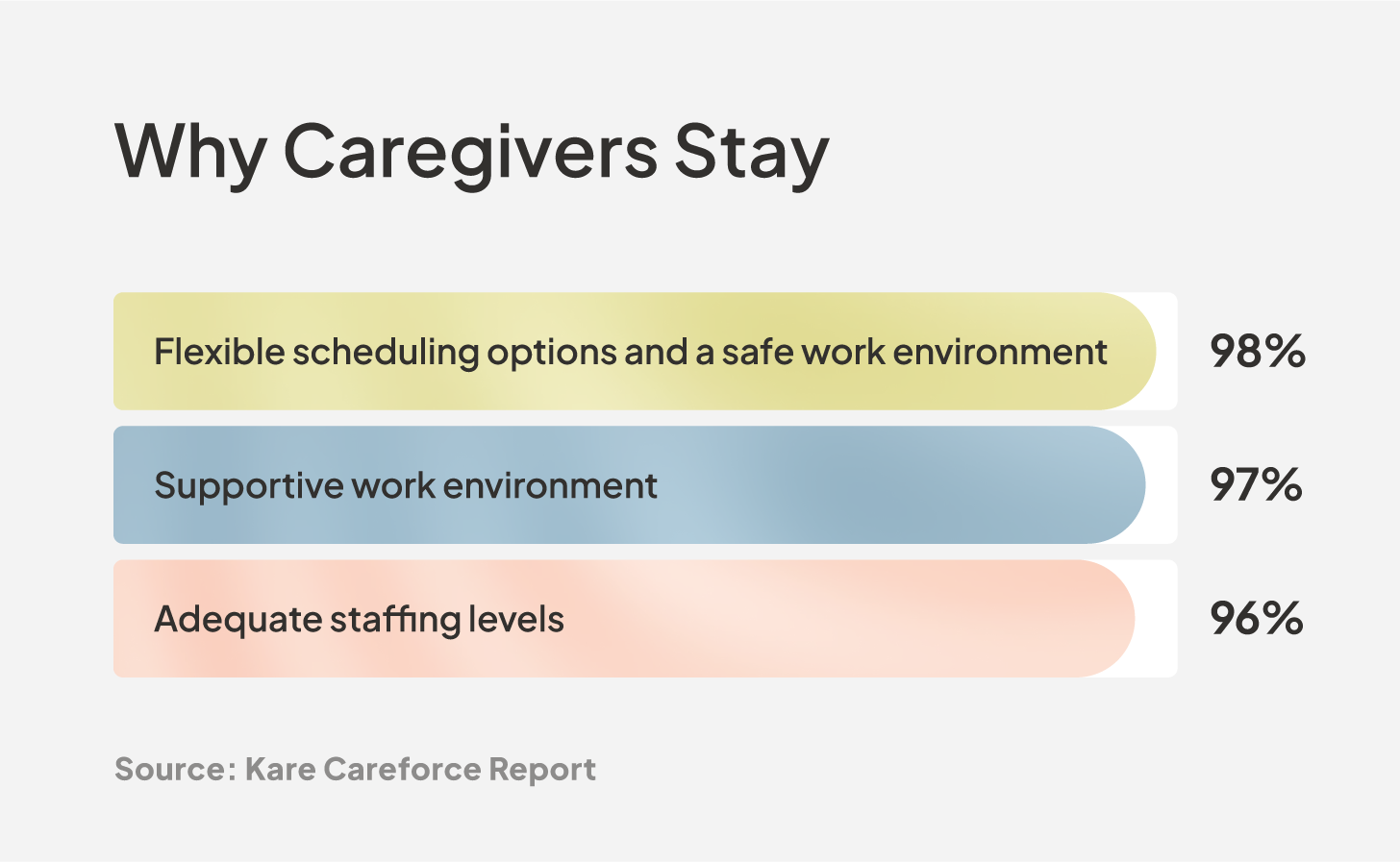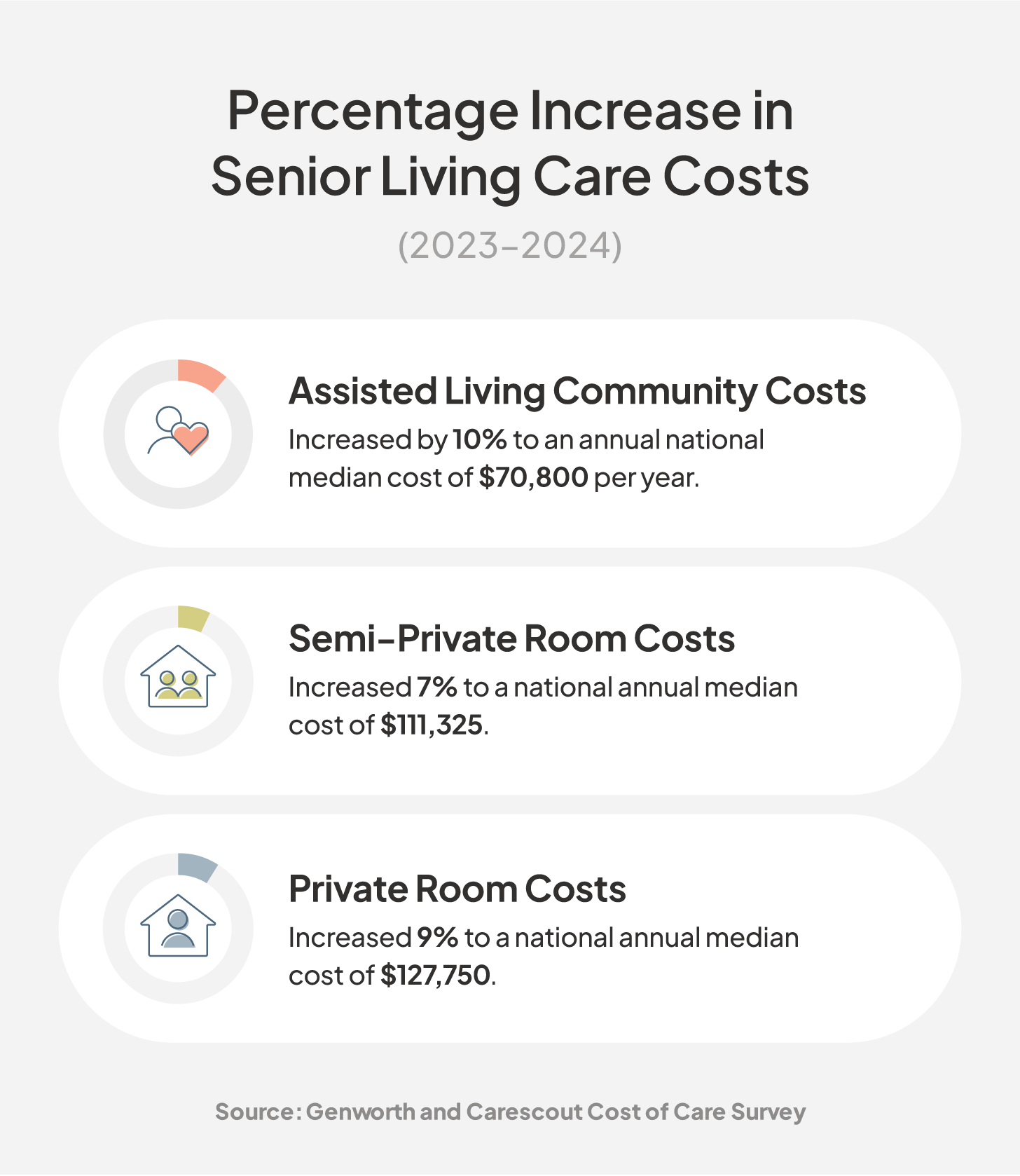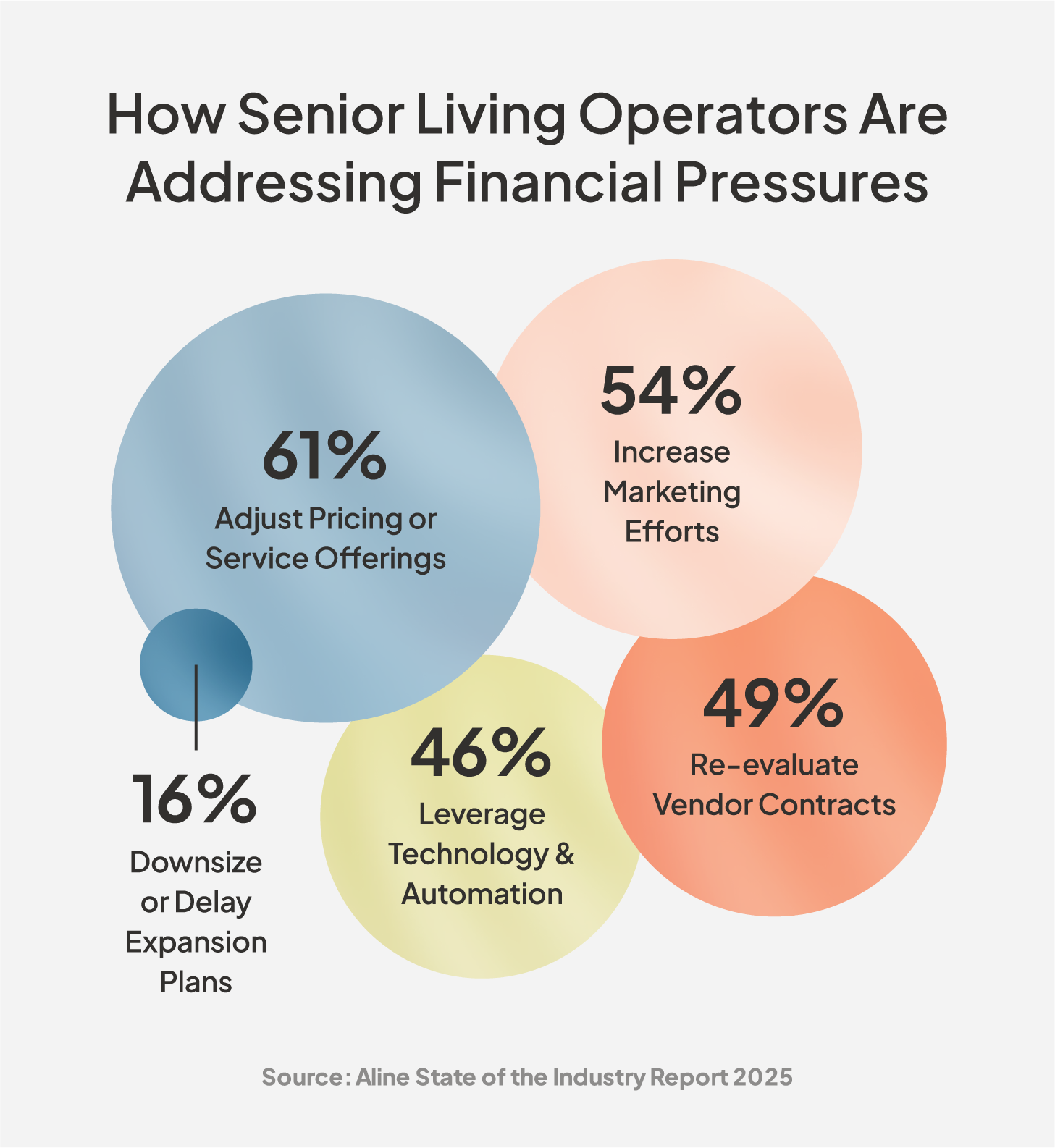5 Ways to Overcome Senior Living Communities’ Biggest Challenges in 2025
Staffing shortages, data silos and occupancy goals continue to challenge senior living communities. An all-in-one software solution can help alleviate those challenges.

Staffing shortages, data silos and occupancy goals continue to challenge senior living communities. An all-in-one software solution can help alleviate those challenges.
Published on: December 6, 2023
Last updated: September 4, 2025

With rising costs, shifting financial markets, staffing shortages, and growing competition, senior living operators are navigating a high-pressure environment in 2025. In fact, our 2025 State of the Senior Living Industry Report confirms just how widespread these pressures have become, surfacing five key challenges that communities across the country are working to overcome:
While the pressure is real, communities aren’t without options. Operational improvements, stronger staff support systems, and more efficient workflows can make a meaningful difference in how teams manage the complexity of today’s landscape.
Technology plays a critical role in making those operational improvements possible. When systems are outdated or disconnected, it becomes harder to access reliable information, coordinate teams, or respond quickly to shifting demands. An interconnected software solution helps communities bring their data, processes, and people into alignment, making it easier to work efficiently and make informed, real-time decisions.
Here’s how the right system can help your community tackle 2025’s biggest senior living challenges and bring more clarity and control to your day-to-day operations.
In our 2025 State of Senior Living Report, leaders across the industry pointed to staffing as one of their most pressing challenges. And it’s not just about hiring. Staff retention, rising wage expectations, and maintaining care quality all contribute to a complex workforce landscape.
Several forces are converging to make the issue even more urgent. As the aging population grows, demand for care is increasing with an estimated need for 660,000 new senior living workers by 2033. At the same time, many caregivers are choosing to leave the industry altogether. A recent Kare survey found that:
Burnout is also a significant driver of turnover, often fueled by scheduling strain, heavy administrative tasks, and a lack of day-to-day support. While better pay and benefits are important, they’re not enough on their own. Caregivers also need work environments that prioritize well-being, reduce unnecessary stress, and give them more time to focus on resident care.

That’s where technology can make a meaningful impact. A senior living operating system can support a more sustainable and efficient work environment, benefiting both caregivers and leadership. With the right solutions, communities can:
Empowered, supported caregivers are essential to delivering consistent, high-quality care. With the right systems in place, communities can ease daily pressures and build a stronger, more engaged workforce.
Operational management remains a persistent challenge for senior living teams, especially when fragmented systems and manual reporting make it hard to access accurate, organization-wide data. Only 25% of leaders say they have complete visibility into the metrics they need.
Consider a typical scenario: Each department — finance, care, sales and marketing, and resident services — uses a different system to manage their data. When leadership needs to assess performance, staff are forced to pull reports from multiple sources, and then compile the information manually into spreadsheets.
This process invites errors, including mistyped entries, broken formulas, or overlooked fields, and can easily result in incomplete or inaccurate reporting. If decisions are made based on flawed data, the consequences can affect compliance, care quality, and operational performance.
An interconnected senior living platform simplifies that process by bringing everything into one centralized dashboard. From this single source of truth, you can:
As AI capabilities advance, these systems will continue to evolve, offering predictive insights that support proactive planning. Operators will gain the ability to forecast things like expansion needs, maintenance schedules, resource allocation, and even resident care demands. The result is a clearer, more accurate view of where your community is headed and how to scale effectively.
Related: For a deep dive into the senior living’s performance metrics, download the Aline Benchmark Report.
Operators across the senior living industry are feeling the pressure of growing competition and tightening pricing dynamics. To stay competitive, communities must offer flexible pricing models and clearly differentiated services that speak to what today’s residents and families value most.
Longer lifespans and healthier aging, backed by Stanford’s research on longevity, are shifting expectations around senior living. Residents are looking for more personalized options, enriched amenities, and engaging lifestyle programming. At the same time, private equity investment has fueled market growth, raising the stakes for communities trying to stand out.
Delivering superior care and a positive resident experience are at the heart of every senior living community’s mission. While these may be common goals, they’re certainly not easy to achieve. Balancing individualized care, emotional connection, and operational scalability is a daily challenge.
Meanwhile, costs are rising. According to Genworth and CareScout’s 2024 Cost of Care Survey, expenses for most types of care outpaced inflation. Assisted living saw a 10% year-over-year increase while occupancy rates rose from 77% to 84, a signal that demand is recovering but with tighter margins in play.

Purpose-built senior living software helps communities respond to pricing pressure and increased competition by centralizing key data in one accessible view. With clearer insights, operators can make faster, more informed decisions around care delivery, pricing, and differentiation. For example, senior living teams can:
Looking ahead, AI capabilities, like those found in Aline Intelligence, will continue to enhance these insights. Communities will gain solutions for real-time competitive analysis, social media and review monitoring, and optimized marketing spend through campaign performance tracking.
The payoff: stronger data intelligence to build a smarter strategy. When communities align their services, pricing, and resident experience, they not only improve retention, but they also create a place people want to call home.

Rising employee costs continue to put pressure on senior living operators, forcing many to rethink their labor models and cost-control strategies. Higher wages, growing benefits expectations, and expanded regulatory requirements all play a role.
According to the Kare Careforce Report, while 29% of caregivers leave their jobs due to low pay, only 3% stay for that reason. Roles like certified medical assistants and certified nursing assistants are particularly vulnerable to turnover tied to compensation.
Still, pay alone doesn’t determine retention. Factors like career development, work culture, and scheduling flexibility matter just as much.
Meeting those needs often adds to costs. Training and certification programs can boost employee satisfaction and care quality, but they also require investment. That’s why it’s essential for operators to closely monitor wage trends, competitor pay practices, and staff sentiment while also keeping a firm grip on their own labor data.
At the same time, compliance costs are climbing. The NCAL Assisted Living State Regulatory Review shows increased regulatory activity at both state and federal levels, especially around infection control and quality standards. For example, the 2024 reauthorization of the Older Americans Act includes new requirements related to healthy aging, economic security, and senior centers with compliance deadlines set for October 2025.
Purpose-built senior living software can ease this burden by helping operators control costs through real-time operational insights and automation. With a connected system, teams can:
AI-powered insights will continue to help operators optimize employee and compliance costs into the future. As the technology progresses, look for AI-backed training modules to improve training efficiency and competitive intelligence, which can help monitor how competitors save costs and what they’re paying their staff.
Meeting occupancy goals has long been an issue for senior living communities, and that challenge isn’t going away in 2025. In fact, during a recent Aline webinar, “Aline on the Future of Senior Living,” 50 percent of attendees cited this as their top challenge for the upcoming year.
Balancing occupancy rates with affordability challenges operators in a few key areas:
One underlying issue across these challenges is fragmented data. When information is siloed, teams struggle to identify trends, understand resident behavior, or respond to market demands. For example, disconnected systems can prevent marketing teams from spotting common decision drivers or make it harder to track why residents leave.
Interconnected senior living software helps bring clarity to the full occupancy picture. By integrating operational, financial, sales and marketing, and care data, operators can:
With better visibility into what drives both move-ins and move-outs, communities are better equipped to maintain stable occupancy while doing so in a way that supports both profitability and resident satisfaction.
Senior living operators face several challenges, but these don’t have to hold you back from getting ahead in the market. An interconnected senior living software solution can help you leverage smarter, deeper data and help your community thrive.
Patchworked systems and disparate data can put you at a disadvantage in today’s highly connected and competitive market. Opting for a solution to connect your systems and centrally gather up-to-date information is your advantage.
While there’s no “easy” fix to the biggest senior living challenges, the right technology can make a difference. See how Aline can help through interconnected senior living software and AI-powered solutions.
Download our guide to smarter senior living software and stronger operational performance.


Amanda McGrory-Dixon
Amanda McGrory-Dixon is the content marketing manager at Aline, where she shares expert insights on how senior living communities can streamline operations, enhance resident satisfaction, and drive sustainable growth. With a deep understanding of industry trends and technology, she helps operators navigate challenges and implement data-driven strategies to improve efficiency, profitability, and care outcomes.
Blogs, stories and studies from the forefront of senior living operations

Lead generation surveys give senior living operators the data they need to understand their market, uncover new opportunities, and drive occupancy growth.

Prospect-centered selling helps senior living operators convert more leads and achieve occupancy goals through a more personalized, empathetic approach.

Gain insight into senior living pricing strategies for community success. Explore how Aline’s software optimizes revenue and operations

Overcome the biggest senior living financial challenges, including operational costs and occupancy rates, with interconnected software

Take a look at how senior living software options, like Aline, can elevate operations, resident care, and ROI

Enhance efficiency, accuracy, and resident satisfaction by integrating a POS system into your senior living dining operations
We’re using cookies on this site to improve your experience. Cookies help us learn how you interact with our website, and remember you when you come back so we can tailor it to your interests.
You can find out more about cookies and usage on our cookie policy page.
Some of these cookies are essential, while others help us to improve your experience by providing insights into how the site is being used.
For more detailed information on the cookies we use, please check our privacy policy
Your experience is important to us. We’re redirecting you to our new Aline website, where you’ll discover how our complete suite of senior living solutions can help you grow occupancy and revenue, optimize operations, and enhance resident care.
For more information, you’re welcome to read our statement on our merger. To continue your web experience, simply close this notification.
Your experience is important to us. We’re redirecting you to our new Aline website, where you’ll discover how our complete suite of senior living solutions can help you grow occupancy and revenue, optimize operations, and enhance resident care.
For more information, you’re welcome to read our statement on our merger. To continue your web experience, simply close this notification.
Your experience is important to us. We’re redirecting you to our new Aline website, where you’ll discover how our complete suite of senior living solutions can help you grow occupancy and revenue, optimize operations, and enhance resident care.
For more information, you’re welcome to read our statement on our merger. To continue your web experience, simply close this notification.
Your experience is important to us. We’re redirecting you to our new Aline website, where you’ll discover how our complete suite of senior living solutions can help you grow occupancy and revenue, optimize operations, and enhance resident care.
For more information, you’re welcome to read our statement on our merger. To continue your web experience, simply close this notification.
Aline Innovation Summit 2026: Registration Now Open!
Connect with senior living leaders, innovators, and industry peers May 11-13, 2026, in Frisco, TX to explore the latest innovations, proven strategies, and best practices shaping the future of senior living. View details and register today.